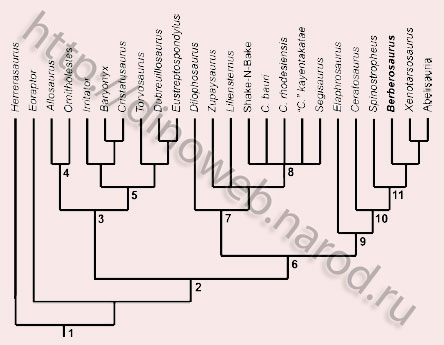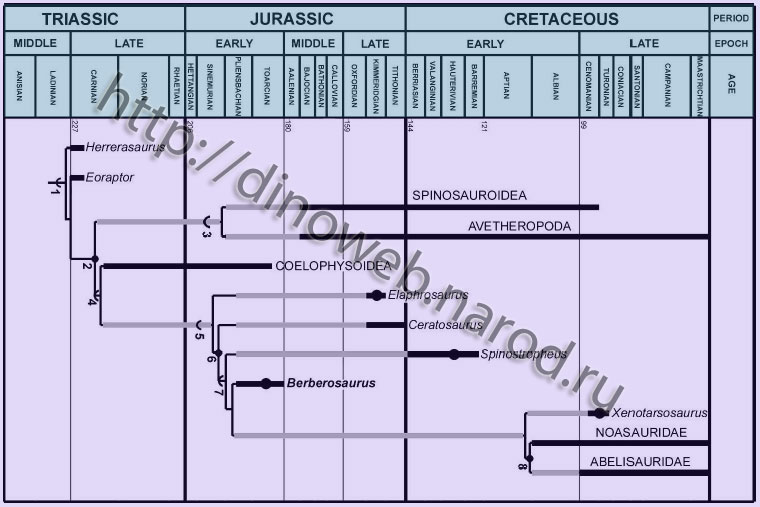
Complete Data Base of Paleozoic and Mesozoic Tetrapods.
Paleo-News and illustrations. Big electronic PDF-library.
| |
| PaleoNews |
| Classification |
| Books and Articles |
| Contact |
| Forum |
сайт о динозаврах
рейтинг сайтов
Free Counter
myspace hit counter
Berberosaurus |
Genus: Berberosaurus Allain, Tykoski, Aquesbi, Jalil, Monbaron, Russell, and Taquet, 2007 Classification: Dinosauria - Saurischia - Theropoda - Ceratosauria - Abelisauroidea Etymology: Generic name is from the Berbers who live mainly in Morocco; “ sauros” is Greek for lizard. Synonyms: none Type species: B. liassicus Allain, Tykoski, Aquesbi, Jalil, Monbaron, Russell, and Taquet, 2007 Other Species: none Diagnosis: as for the type species Species: Berberosaurus liassicus Allain, Tykoski, Aquesbi, Jalil, Monbaron, Russell, and Taquet, 2007 Etymology: Specific name from Lias, referring to the statigraphic epoch of the specimen. Synonyms: none Holotype: Associated postcranial material housed in the Museum d’Histoire Naturelle de Marrakech, including a cervical vertebra (MHNM-Pt9); anterior part of the sacrum (MHNMPt23); the second left metacarpal (MHNM-Pt22); a right femur (MHNM-Pt19); the proximal end of the left tibia (MHNM-Pt21); the distal end of the right tibia (MHNM-Pt16); and the left fibula (MHNM-Pt20). Referred Specimens: MHNM-To1– 218, the proximal end of a right femur. Time: middle to late Early Jurassic (Pliensbachian-Toarcian). Horizon: Upper bone-bed (“ Fossil locality B” of Allain et al., 2004) of the Toundoute continental series. Location: Douar of Tazouda, near the village of Toundoute in the Province of Ouarzazate, High Atlas of Morocco. Total length: ~ 5 m (subadult) and 6-7 m (adult). Mass: 300-600 kg. Diagnosis: Berberosaurus is characterized by the following unique combination of characters that nests the taxon among the abelisauroid ceratosaurs: highly pneumatic cervical vertebrae; anteroposteriorly short cervical vertebral centra with camerate internal structure; cervical neural spine anteroposteriorly short; ventral margin of sacral series strongly arched dorsally; transversely narrow sacral centra; proximal end of the second metacarpal deeply grooved ventrally; femoral anterior trochanter reaches proximally to mid-point of femoral head; large femoral trochanteric shelf; tibia with subtriangular distal profile; presence of an oblique ridge that proximally caps the medial sulcus of the fibula. Berberosaurus differs from Elaphrosaurus in: short cervical centra, pneumatic foramina on the cervical neural arch; from Ceratosaurus in: camerate structure of cervical vertebra, low and short neural spine of the cervical vertebra, femoral anterior trochanter reaches proximally to mid-point of femoral head; from Spinostropheus in: absence of the epipophysealprezygapophyseal lamina on the cervical neural arches, short cervical neural spine; from Abelisauria in: distal end of metacarpal with deep extensor pits; pronounced femoral trochanteric shelf (Allain, Tykoski, Aquesbi, Jalil, Monbaron, Russell, and Taquet, 2007). Comments: The fossil record of abelisauroid carnivorous dinosaurs was previously restricted to Cretaceous sediments of Gondwana and probably Europe. The discovery of an incomplete specimen of a new basal abelisauroid, Berberosaurus liassicus, is reported from the late Early Jurassic of Moroccan High Atlas Mountains. Phylogenetic analysis recovers Ceratosauroidea and Coelophysoidea as sister lineages within Ceratosauria, and Berberosaurus as a basal abelisauroid. Berberosaurus is the oldest known abelisauroid and extends the first appearance datum of this lineage by about 50 million years. The taxon bridges temporal, morphological, and phylogenetic gaps that have hitherto separated Triassic to Early Jurassic coelophysoids from Late Jurassic through Cretaceous ceratosauroids. The discovery of an African abelisauroid in the Early Jurassic confirms at least a Gondwanan distribution of this group long before the Cretaceous (Allain, Tykoski, Aquesbi, Jalil, Monbaron, Russell, and Taquet, 2007). Illustrations: References: © Tetrapoda Database Roman Ulansky roman.ulansky@gmail.com or adios85@mail.ru
|



